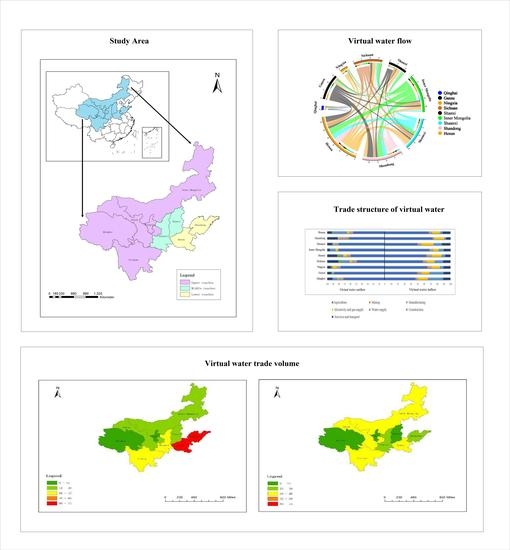Virtual Water Flow Pattern in the Yellow River Basin, China: An Analysis Based on a Multiregional Input–Output Model
Abstract
:1. Introduction
2. Methodology and Materials
2.1. Study Region
2.2. Multi-Regional Input–Output Virtual Water Accounting Framework of the Yellow River Basin
2.2.1. Single-Region Input–Output Model
2.2.2. Modeling of Yellow River Basin Inputs and Outputs on a Multi-Regional Scale
2.2.3. Estimation of Virtual Water Trade Flow
2.2.4. Water Stress Index and Pull Coefficient
2.3. Data Source and Processing
3. Results and Analysis
3.1. Virtual Water Usage of Different Sectors in the Yellow River Basin
3.1.1. Analysis of Sectoral Water Usage Coefficient
3.1.2. Volume of Trade in the Sector of Virtual Water
3.1.3. Pull Coefficient Analysis
3.2. Regional Virtual Flow Pattern in the Yellow River Basin
3.2.1. Trade Volume of Virtual Water
3.2.2. Analysis of Virtual Water and Water-Resource Carrying Capacity
3.3. Virtual Flow Pattern in the Yellow River Basin
4. Discussion
5. Conclusions
5.1. Conclusions
- (1)
- The whole Yellow River region is in a net input state of virtual water. Among them, the upstream areas—Gansu, Inner Mongolia, and Ningxia Province—are in the net output provinces (regions), while the other six provinces belong to the virtual water net input regions. Gansu’s virtual water input and output state is the most seriously incompatible with the local water-resource carrying capacity among all the provinces discussed.
- (2)
- Agriculture is the largest import and export sector of all regions. In addition to agriculture, the upstream region is sufficient in water resources. The main export sector of virtual water is the water supply industry, and those for the middle- and downstream regions are the services and transportation and manufacturing industries, respectively. Obvious differences exist in the pull coefficients of the same sectors in various provinces (regions). On the whole, the average pull coefficients of mining, manufacturing, and construction are large. The water management of these sectors is conducive to rapid water-resource regulation and rational utilization in this region.
- (3)
- The virtual flow of the Yellow River Basin has obvious geographical distribution characteristics. The trade volume of virtual water in the downstream region is large. The volume of virtual water trade within the upper reaches is low, and the trade links with the middle and lower reaches are insufficient. Henan and Shandong Provinces are the main flow directions in the Yellow River Basin, and Gansu and Inner Mongolia are the dominant virtual water sources.
5.2. Suggestions
- (1)
- China should vigorously implement the ecological compensation policy of water usage. Although the region is in the virtual water net input area as a whole, the WSI of Gansu and Ningxia is high, which is seriously inconsistent with the virtual water net output state. The utilization of water resources should be distributed comprehensively throughout the country. By reducing the virtual water flow in Gansu and Ningxia, the local ecological development and water resource allocation balance can be protected. China should also appropriately increase the output of virtual water in Sichuan and grasp the advantages of local green water resources. Meanwhile, we recommend increasing the virtual water output from other surplus provinces to Henan and Shandong Provinces, reducing the pressures of water outflow, and ensuring local water safety and ecological security.
- (2)
- All industry sectors should adhere to the principle of “determining production by water”. The whole Yellow River Basin should develop water-saving agricultural techniques, change the traditional mode of agricultural production, strictly control the total water, and improve water-usage efficiency. The upper reaches of the Yellow River Basin should enforce the technological innovation investment and water-use efficiency, and the regional water-shortage situation should be alleviated by importing water-intensive products to water-rich areas; The middle reaches should speed up the transformation to a resource-based economy, develop water-saving industries, and vigorously develop the service and transportation industry; The lower reaches should speed up the development of high value-added manufacturing industries and strengthen economic ties inside and outside the region.
- (3)
- China should fully strengthen the exchanges and cooperation between the lower, middle, and upper reaches, and actively explore the institutional mechanism of water ecological protection. China should establish an internal, cooperative development mechanism in this region with the goals of common economic development, water conservation, and ecological protection. Through trade-oriented interprovincial cooperation, China should reduce the intermediate links of ineffective water use, make the virtual water flow to the most needy regions and sectors, improve water sewage efficiency, and drive economic development. China should also comprehensively improve the interprovincial virtual water-trade flow, give full play to the economic ties between the lower, middle, and upper reaches, and jointly realize the sustainable development of the economy, as well as the ecological environment.
Author Contributions
Funding
Institutional Review Board Statement
Informed Consent Statement
Data Availability Statement
Acknowledgments
Conflicts of Interest
References
- Abd Ellah, R.G. Water resources in Egypt and their challenges, Lake Nasser case study. Egypt J. Aqua. Res. 2020, 46, 1–12. [Google Scholar] [CrossRef]
- Fidélis, T.; Cardoso, A.S.; Riazi, F.; Miranda, A.C.; Abrantes, J.; Teles, F.; Roebeling, P.C. Policy narratives of circular economy in the EU—Assessing the embeddedness of water and land in national action plans. J. Clean. Prod. 2021, 288, 125685. [Google Scholar] [CrossRef]
- Kundzewicz, Z.W. Global freshwater resources for sustainable development. Ecohydrol. Hydrobiol. 2007, 7, 125–134. [Google Scholar] [CrossRef]
- Karimidastenaei, Z.; Avellán, T.; Sadegh, M.; Kløve, B.; Haghighi, A.T. Unconventional water resources: Global opportunities and challenges. Sci. Total Environ. 2022, 827, 154429. [Google Scholar] [CrossRef]
- Vahidipour, M.; Raeisi, E.; van der Zee, S.E.A.T. Active saltwater intrusion of shrinking Bakhtegan -Thask Lakes in South Iran threatens the freshwater resources of coastal aquifers. J. Hydrol.-Reg. Stud. 2021, 34, 100790. [Google Scholar] [CrossRef]
- Li, R.; Wu, M.; Aleid, S.; Zhang, C.; Wang, W.; Wang, P. An integrated solar-driven system produces electricity with fresh water and crops in arid regions. Cell Rep. Phys. Sci. 2022, 3, 100781. [Google Scholar] [CrossRef]
- Alsulaili, A.; Alkandari, M.; Buqammaz, A. Assessing the impacts of meteorological factors on freshwater consumption in arid regions and forecasting the freshwater demand. Environ. Technol. Innov. 2022, 25, 102099. [Google Scholar] [CrossRef]
- Elbeih, S.F.; Madani, A.A.; Hagage, M. Groundwater deterioration in Akhmim District, Upper Egypt: A Remote Sensing and GIS investigation approach. Egypt J. Remote. Sens. 2021, 24, 919–932. [Google Scholar] [CrossRef]
- De, O.; Vieira, E.; Sandoval-Solis, S. Water resources sustainability index for a water-stressed basin in Brazil. J. Hydrol.-Reg. Stud. 2018, 19, 97–109. [Google Scholar]
- Ercin, E. Overuse of Water Resources: Water Stress and the Implications for Food and Agriculture-ScienceDirect. Encycl. Food Secur. Sustain. 2019, 1, 206–211. [Google Scholar]
- Hemmat Esfe, M.; Toghraie, D. Numerical study on the effect of solar radiation intensity on the fresh water productivity of solar still equipped with Thermoelectric Cooling System (TEC) for hot and dry areas of Semnan. Case Stud. Therm. Eng. 2022, 32, 101848. [Google Scholar] [CrossRef]
- Muratoglu, A. Water footprint assessment within a catchment: A case study for Upper Tigris River Basin. Ecol. Indic. 2019, 106, 105467. [Google Scholar] [CrossRef]
- Salehi, M. Global water shortage and potable water safety; Today’s concern and tomorrow’s crisis. Environ. Int. 2022, 158, 106936. [Google Scholar] [CrossRef]
- Ahmed, M.; Wiese, D.N. Short-term trends in Africa’s freshwater resources: Rates and drivers. Sci. Total. Environ. 2019, 695, 133843. [Google Scholar] [CrossRef]
- Baluyot, J.C.; Reyes, E.M.; Velarde, M.C. Per- and polyfluoroalkyl substances (PFAS) as contaminants of emerging concern in Asia’s freshwater resources. Environ. Res. 2021, 197, 111122. [Google Scholar] [CrossRef]
- Baccour, S.; Albiac, J.; Kahil, T.; Esteban, E.; Crespo, D.; Dinar, A. Hydroeconomic modeling for assessing water scarcity and agricultural pollution abatement policies in the Ebro River Basin, Spain. J. Clean. Prod. 2021, 327, 129459. [Google Scholar] [CrossRef]
- Sabzevar, M.S.; Rezaei, A.; Khaleghi, B. Incremental adaptation strategies for agricultural water management under water scarcity condition in Northeast Iran. Reg. Sustain. 2021, 2, 224–238. [Google Scholar] [CrossRef]
- Li, K.; Hajar, S.; Ding, Z.; Dooling, T.; Wei, G.; Hu, C.; Zhang, Y.; Zhang, K. Dynamic optimization of input production factors for urban industrial water supply and demand management. J. Environ. Manag. 2020, 270, 110807. [Google Scholar] [CrossRef]
- Murali, S.; Krishnan, V.S.; Amulya, P.R.; Alfiya, P.V.; Delfiya, D.S.A.; Samuel, M.P. Energy and water consumption pattern in seafood processing industries and its optimization methodologies. Clean Eng. Technol. 2021, 4, 100242. [Google Scholar] [CrossRef]
- Karandish, F.; Hogeboom, R.J.; Hoekstra, A.Y. Physical versus virtual water transfers to overcome local water shortages: A comparative analysis of impacts. Adv. Water Resour. 2021, 147, 103811. [Google Scholar] [CrossRef]
- Adrielly Nahomee, R.Á.; de Fátima, M.S.G.; Mota Idalia, F.D.L.; Francisca Irene, S.A. Reaching sustainability through a smart water crisis-proof industry. Process Comput. Sci. 2021, 180, 86–92. [Google Scholar] [CrossRef]
- Li, X.; Zhang, L.; Zheng, Y.; Yang, D.; Wu, F.; Tian, Y.; Han, F.; Gao, B.; Li, H.; Zhang, Y.; et al. Novel hybrid coupling of ecohydrology and socioeconomy at river basin scale: A watershed system model for the Heihe River basin. Environ. Modell. Softw. 2021, 141, 105058. [Google Scholar] [CrossRef]
- Zhang, Y.; Deng, J.; Qin, B.; Zhu, G. Importance and vulnerability of lakes and reservoirs supporting drinking water in China. Fund. Res. 2022, 1, 35. [Google Scholar] [CrossRef]
- Cao, T.; Wang, S.; Chen, B. Water shortage risk transferred through interprovincial trade in Northeast China. Energy Procedia 2019, 158, 3865–3871. [Google Scholar] [CrossRef]
- Mu, Y.; Li, X.; Guo, Y.; Liang, C.; Bai, J.; Linke, S.; Cui, B. Using climatic-geomorphological surrogates to identify complete and incidental freshwater conservation gaps within large river basins in China. Glob. Ecol. Conserv. 2021, 30, e01744. [Google Scholar] [CrossRef]
- Chen, C.; Jiang, Y.; Ye, Z.; Yang, Y.; Hou, L.A. Sustainably integrating desalination with solar power to overcome future freshwater scarcity in China. Glob. Energy Intercon. 2019, 2, 98–113. [Google Scholar]
- Li, D.; Zuo, Q.; Zhang, Z. A new assessment method of sustainable water resources utilization considering fair-ness-efficiency-security: A case study of 31 provinces and cities in China. Sustain. Cities Soc. 2022, 81, 103839. [Google Scholar] [CrossRef]
- Qin, J.; Ding, Y.; Zhao, Q.; Wang, S.; Chang, Y. Assessments on surface water resources and their vulnerability and adapta-bility in China. Adv. Clim. Chang. Res. 2020, 11, 381–391. [Google Scholar] [CrossRef]
- Liu, X.; Tan, T.; Bai, Y.; Chou, L. Restoration performance of regional soil and water resources in China based on index of coupling and improved assessment tool. Alex. Eng. J. 2022, 61, 5677–5686. [Google Scholar] [CrossRef]
- An, T.; Wang, L.; Gao, X.; Han, X.; Zhao, Y.; Lin, L.; Wu, P. Simulation of the virtual water flow pattern associated with in-terprovincial grain trade and its impact on water resources stress in China. J. Clean. Prod. 2021, 288, 125670. [Google Scholar] [CrossRef]
- Deng, J.; Li, C.; Wang, L.; Yu, S.; Zhang, X.; Wang, Z. The impact of water scarcity on Chinese inter-provincial virtual water trade. Sustain. Prod. Consump. 2021, 28, 1699–1707. [Google Scholar] [CrossRef]
- Lin, L.; Gao, X.; Zhao, Y.; Wang, L.; An, T.; Liu, C.; Qiao, Y.; Wu, P. Evaluation of the water consumption of animal products and the virtual water flow pattern associated with interprovincial trade in China. J. Clean. Prod. 2021, 328, 129599. [Google Scholar] [CrossRef]
- Gu, D.; Guo, J.; Fan, Y.; Zuo, Q.; Yu, L. Evaluating water-energy-food system of Yellow River basin based on type-2 fuzzy sets and Pressure-State-Response model. Agr. Water Manag. 2022, 267, 107607. [Google Scholar] [CrossRef]
- Li, X.; Zhang, X.; Wang, S. Managing conflicts and equitability in hierarchical decision making for water resources planning under fuzzy uncertainty: A case study of Yellow River, China. J. Hydrol.-Reg. Stud. 2021, 38, 100963. [Google Scholar] [CrossRef]
- Jiang, L.; Zuo, Q.; Ma, J.; Zhang, Z. Evaluation and prediction of the level of high-quality development: A case study of the Yellow River Basin, China. Ecol. Indic. 2021, 129, 107994. [Google Scholar] [CrossRef]
- Li, M.; Tian, Q.; Yu, Y.; Xu, Y.; Li, C. Virtual Water Trade in the Yellow River Economic Belt: A Multi-Regional Input-Output Model. Water 2021, 13, 748. [Google Scholar] [CrossRef]
- Fan, G.; Zhang, D.; Zhang, J.; Li, Z.; Sang, W.; Zhao, L.; Xu, M. Ecological environmental effects of Yellow River irrigation revealed by isotope and ion hydrochemistry in the Yinchuan Plain, Northwest China. Ecol. Indic. 2022, 135, 108574. [Google Scholar] [CrossRef]
- Chen, Y.; Zhu, M.; Lu, J.; Zhou, Q.; Ma, W. Evaluation of ecological city and analysis of obstacle factors under the background of high-quality development: Taking cities in the Yellow River Basin as examples. Ecol. Indic. 2020, 118, 106771. [Google Scholar] [CrossRef]
- Zuo, Q.; Guo, J.; Ma, J.; Cui, G.; Yang, R.; Yu, L. Assessment of regional-scale water resources carrying capacity based on fuzzy multiple attribute decision-making and scenario simulation. Ecol. Indic. 2021, 130, 108034. [Google Scholar] [CrossRef]
- Khorsandi, M.; Homayouni, S.; van Oel, P. The edge of the petri dish for a nation: Water resources carrying capacity as-sessment for Iran. Sci. Total Environ. 2022, 817, 153038. [Google Scholar] [CrossRef]
- Feng, K.; Siu, Y.L.; Guan, D.; Hubacek, K. Assessing regional virtual water flows and water footprints in the Yellow River Basin, China: A consumption based approach. Appl. Geogr. 2012, 32, 691–701. [Google Scholar] [CrossRef]
- Zhao, Y.; Wang, Y.; Wang, Y. Comprehensive evaluation and influencing factors of urban agglomeration water resources carrying capacity. J. Clean. Prod. 2021, 288, 125097. [Google Scholar] [CrossRef]
- Peng, T.; Deng, H.; Lin, Y.; Jin, Z. Assessment on water resources carrying capacity in karst areas by using an innovative DPESBRM concept model and cloud model. Sci. Total Environ. 2021, 767, 144353. [Google Scholar] [CrossRef] [PubMed]
- Allan, J.A. Fortunately There Are Substitutes for Water: Otherwise Our Hydropolitical Futures Would be Impossible. Priori-Ties Water Res. Alloca. Manag. 1993, 13, 26. [Google Scholar]
- Oreggioni, F.; Garcia, S.; Gomez, M.; Mejia, A. A machine learning model of virtual water networks over time. Adv. Water Resour. 2021, 147, 103819. [Google Scholar] [CrossRef]
- Almazán-Gómez, M.A.; Duarte, R.; Langarita, R.; Sánchez-Chóliz, J. Effects of water re-allocation in the Ebro river basin: A multiregional input-output and geographical analysis. J. Environ. Manag. 2019, 241, 645–657. [Google Scholar] [CrossRef]
- Grazzini, J.; Spelta, A. An empirical analysis of the global input–output network and its evolution. Physica A 2022, 594, 126993. [Google Scholar] [CrossRef]
- Sun, J.X.; Yin, Y.L.; Sun, S.K.; Wang, Y.B.; Yu, X.; Yan, K. Review on research status of virtual water: The perspective of ac-counting methods, impact assessment and limitations. Agr. Water Manag. 2021, 243, 106407. [Google Scholar] [CrossRef]
- Zhang, Y.; Hou, S.; Chen, S.; Long, H.; Liu, J.; Wang, J. Tracking flows and network dynamics of virtual water in electricity transmission across China. Renew. Renew. Sustain. Energy Rev. 2021, 137, 110475. [Google Scholar] [CrossRef]
- Garcia, S.; Mejia, A. Characterizing and modeling subnational virtual water networks of US agricultural and industrial commodity flows. Adv. Water. Resour. 2019, 130, 314–324. [Google Scholar] [CrossRef]
- Cegar, S. Water extended input-output analysis of the Croatian economy. J. Econ. Bus. 2020, 38, 147–182. [Google Scholar]
- Gkatsikos, A.; Mattas, K. The Paradox of the Virtual Water Trade Balance in the Mediterranean Region. Sustainability 2021, 13, 2978. [Google Scholar] [CrossRef]
- Houyin, L.; Yangting, O.; Hong, Z. Water footprint and virtual water flows embodied in China’s supply chain. Int. J. Logist. 2021, 25, 1–16. [Google Scholar] [CrossRef]
- Zhang, Y.; Fu, Z.; Xie, Y.; Li, Z.; Liu, Y.; Zhang, B.; Guo, H. Dynamic metabolism network simulation for energy-water nexus analysis: A case study of Liaoning Province, China. Sci. Total. Environ. 2021, 779, 146440. [Google Scholar] [CrossRef]
- Yang, Y.; Liu, S.; Xiao, C.; Feng, C.; Li, C. Evaluating Cryospheric Water Withdrawal and Virtual Water Flows in Tarim River Basin of China: An Input-Output Analysis. Sustainability 2021, 13, 7589. [Google Scholar] [CrossRef]
- Fu, Y.; Huang, G.; Liu, L.; Li, J.; Pan, X. Multi-hierarchy virtual-water management–A Case Study of Hubei Province, China. J. Clean. Prod. 2021, 293, 126244. [Google Scholar] [CrossRef]
- Zhang, J.L.; Jiang, G.Q.; Yang, L.B.; Zhao, Y.T. Study on Virtual Water Consumption and Trade Based on Input-output Analysis in Inner Mongolia. Water Res. Power 2018, 36, 52–54. [Google Scholar]
- Islam, K.M.N.; Kenway, S.J.; Renouf, M.A.; Wiedmann, T.; Lam, K.L. A multi-regional input-output analysis of direct and virtual urban water flows to reduce city water footprints in Australia. Sustain. Cities Soc. 2021, 75, 103236. [Google Scholar] [CrossRef]
- Qasemipour, E.; Tarahomi, F.; Pahlow, M.; Malek, S.S.S.; Abbasi, A. Assessment of Virtual Water Flows in Iran Using a Multi-Regional Input-Output Analysis. Sustainability 2020, 12, 7424. [Google Scholar] [CrossRef]
- Dong, H.; Geng, Y.; Hao, D.; Yu, Y.; Chen, Y. Virtual water flow feature of water-rich province and the enlightenments: Case of Yunnan in China. J. Clean. Prod. 2019, 235, 328–336. [Google Scholar] [CrossRef]
- Chen, W.; Wu, S.; Lei, Y.; Li, S. China’s water footprint by province, and inter-provincial transfer of virtual water. Ecol. Indic. 2017, 74, 321–333. [Google Scholar] [CrossRef]
- Wang, S.; Chen, B. Energy-water nexus of urban agglomeration based on multiregional input–output tables and ecological network analysis: A case study of the Beijing–Tianjin–Hebei region. Appl. Energ. 2016, 178, 773–783. [Google Scholar] [CrossRef]
- Zhang, W.; Fan, X.; Liu, Y.; Wang, S.; Chen, B. Spillover risk analysis of virtual water trade based on multi-regional in-put-output model—A case study. J. Environ. Manag. 2020, 275, 111242. [Google Scholar] [CrossRef]
- Wang, X.; Chen, Y.; Li, Z.; Fang, G.; Wang, Y. Development and utilization of water resources and assessment of water se-curity in Central Asia. Agr. Water. Manag. 2020, 240, 106297. [Google Scholar] [CrossRef]
- Zhang, J.; Chen, Y.; Li, Z.; Song, J.; Fang, G.; Li, Y.; Zhang, Q. Study on the utilization efficiency of land and water resources in the Aral Sea Basin, Central Asia. Sustain. Cities Soc. 2019, 51, 101693. [Google Scholar] [CrossRef]
- Zheng, X.; Huang, G.; Liu, L.; Zheng, B.; Zhang, X. A multi-source virtual water metabolism model for urban systems. J. Clean. Prod. 2020, 275, 124107. [Google Scholar] [CrossRef]
- Wang, Y.; Xian, C.; Jiang, Y.; Pan, X.; Ouyang, Z. Anthropogenic reactive nitrogen releases and gray water footprints in urban water pollution evaluation: The case of Shenzhen City, China. Environ. Dev. Sustain. 2020, 22, 6343–6361. [Google Scholar] [CrossRef]
- Rosales-Asensio, E.; García-Moya, F.J.; González-Martínez, A.; Borge-Diez, D.; de Simón-Martín, M. Stress mitigation of conventional water resources in water-scarce areas through the use of renewable energy powered desalination plants: An application to the Canary Islands. Energy Rep. 2020, 6, 124–135. [Google Scholar] [CrossRef]
- Gohar, A.A.; Cashman, A.; Ward, F.A. Managing food and water security in Small Island States: New evidence from economic modelling of climate stressed groundwater resources. J. Hydrol. 2019, 569, 239–251. [Google Scholar] [CrossRef]
- Sun, S.; Wang, Y.; Engel, B.A.; Wu, P. Effects of virtual water flow on regional water resources stress: A case study of grain in China. Sci. Total Environ. 2016, 550, 871–879. [Google Scholar] [CrossRef] [PubMed]
- Liu, M.; Wei, J.; Wang, G.; Wang, F. Water resources stress assessment and risk early warning—A case of Hebei Province China. Ecol. Indic. 2017, 73, 358–368. [Google Scholar] [CrossRef]
- Yin, Y.L.; Sun, S.K.; Wang, Y.B.; Li, C.; Sun, J.X.; Wu, P.T. Impact of grain virtual water flow on surface water and ground-water in China. Adv. Water Resour. 2021, 150, 103848. [Google Scholar] [CrossRef]
- Liu, J.; Chen, X.; Shi, W.; Chen, P.; Zhang, Y.; Hu, J.; Dong, S.; Li, T. Tectonically controlled evolution of the Yellow River drainage system in the Weihe region, North China: Constraints from sedimentation, mineralogy and geochemistry. J. Asian Earth. Sci. 2019, 179, 350–364. [Google Scholar] [CrossRef]
- Leontief, W. Quantitative Input and Output Relations in the Economic Systems of the United States. Rev. Econ. Stat. 1936, 18, 105–125. [Google Scholar] [CrossRef] [Green Version]
- Rocco, M.V.; Colombo, E. Evaluating energy embodied in national products through Input-Output analysis: Theoretical definition and practical application of international trades treatment methods. J. Clean. Prod. 2016, 139, 1449–1462. [Google Scholar] [CrossRef]
- Guo, J.; Zhang, Y.; Zhang, K. The key sectors for energy conservation and carbon emissions reduction in China: Evidence from the input-output method. J. Clean. Prod. 2018, 179, 180–190. [Google Scholar] [CrossRef]
- Richter, J.S.; Mendis, G.P.; Nies, L.; Sutherland, J.W. A method for economic input-output social impact analysis with ap-plication to U.S. advanced manufacturing. J. Clean. Prod. 2019, 212, 302–312. [Google Scholar] [CrossRef]
- Pfister, S.; Koehler, A.; Hellweg, S. Assessing the environmental impacts of freshwater consumption in LCA. Environ. Sci. Technol. 2009, 43, 4098–4104. [Google Scholar] [CrossRef] [Green Version]
- Hong, S.; Wang, H.; Cheng, T. Analysis of water use characteristics in industrial sectors in Beijing based on an input-output method. Water Sci. Technol. 2020, 20, 219–230. [Google Scholar] [CrossRef]
- Boero, R.; Pasqualini, D. Regional water coefficients for U.S. industrial sectors. Water Resour. Ind. 2017, 18, 60–70. [Google Scholar] [CrossRef]
- White, D.J.; Feng, K.; Sun, L.; Hubacek, K. A hydro-economic MRIO analysis of the Haihe River Basin’s water footprint and water stress. Ecol. Model. 2015, 318, 157–167. [Google Scholar] [CrossRef]
- Zheng, H.; Zhang, Z.; Wei, W.; Song, M.; Guan, D. Regional determinants of China’ consumption-based emissions in the economic transition. Environ. Res. Lett. 2020, 15, 1748–9326. [Google Scholar] [CrossRef]
- Zhang, K.; Lu, H.; Tian, P.; Guan, Y.; Kang, Y.; He, L.; Fan, X. Analysis of the relationship between water and energy in China based on a multi-regional input-output method. J. Environ. Manag. 2022, 309, 114680. [Google Scholar] [CrossRef]
- Wang, F.; Cai, B.; Hu, X.; Liu, Y.; Zhang, W. Exploring solutions to alleviate the regional water stress from virtual water flows in China. Sci. Total Environ. 2021, 796, 148971. [Google Scholar] [CrossRef]
- Liu, Z.; Huang, Q.; He, C.; Wang, C.; Wang, Y.; Li, K. Water-energy nexus within urban agglomeration: An assessment framework combining the multiregional input-output model, virtual water, and embodied energy. Resour. Conserv. Recy. 2021, 164, 105113. [Google Scholar] [CrossRef]
- Gao, X.; Chen, Q.; Lu, S.; Wang, Y.; An, T.; Zhuo, L.; Wu, P. Impact of virtual water flow with the energy product transfer on sustainable water resources utilization in the main coal-fired power energy bases of Northern China. Energy Procedia 2018, 152, 293–301. [Google Scholar] [CrossRef]
- Zhang, S.; Taiebat, M.; Liu, Y.; Qu, S.; Liang, S.; Xu, M. Regional water footprints and interregional virtual water transfers in China. J. Clean. Prod. 2019, 228, 1401–1412. [Google Scholar] [CrossRef]
- Shao, L.; Guan, D.; Wu, Z.; Wang, P.; Chen, G.Q. Multi-scale input-output analysis of consumption-based water resources: Method and application. J. Clean. Prod. 2017, 164, 338–346. [Google Scholar] [CrossRef] [Green Version]
- Shi, C.; Zhan, J. An input–output table based analysis on the virtual water by sectors with the five northwest provinces in China. Phys. Chem. Earth 2015, 79–82, 47–53. [Google Scholar] [CrossRef]
- Chen, W.; Wu, S.; Lei, Y.; Li, S. Virtual water export and import in China’s foreign trade: A quantification using input-output tables of China from 2000 to 2012. Resour. Conserv. Recy. 2018, 132, 278–290. [Google Scholar] [CrossRef]
- Hirwa, H.; Peng, Y.; Zhang, Q.; Qiao, Y.; Leng, P.; Tian, C.; Yang, G.; Muhirwa, F.; Diop, S.; Kayiranga, A.; et al. Virtual water transfers in Africa: Assessing topical condition of water scarcity, water savings, and policy implications. Sci. Total Environ. 2022, 835, 155343. [Google Scholar] [CrossRef] [PubMed]
- Zhang, Y.; Li, J.; Tian, Y.; Deng, Y.; Xie, K. Virtual water flow associated with interprovincial coal transfer in China: Impacts and suggestions for mitigation. J. Clean. Prod. 2021, 289, 125800. [Google Scholar] [CrossRef]
- Xin, M.; Wang, J.; Xing, Z. Decline of virtual water inequality in China’s inter-provincial trade: An environmental economic trade-off analysis. Sci. Total Environ. 2022, 806, 150524. [Google Scholar] [CrossRef] [PubMed]
- Han, X.; Zhang, Y.; Wang, H.; Shi, H. Analyzing the driving mechanisms of grain virtual water flow based on the case of China’s main grains. Environ. Sci. Policy. 2021, 124, 645–655. [Google Scholar] [CrossRef]
- Han, X.; Zhao, Y.; Gao, X.; Jiang, S.; Lin, L.; An, T. Virtual water output intensifies the water scarcity in Northwest China: Current situation, problem analysis and countermeasures. Sci. Total Environ. 2021, 765, 144276. [Google Scholar] [CrossRef]
- Yin, Y.; Luan, X.; Sun, S.; Wang, Y.; Wu, P.; Wang, X. Environmental impact of grain virtual water flows in China: From 1997 to 2014. Agr. Water. Manag. 2021, 256, 107127. [Google Scholar] [CrossRef]
- Liu, G.; Zhang, F.; Deng, X. Is virtual water trade beneficial for the water-deficient regions? New evidences from the Yellow River Basin, China. J. Hydrol.-Reg. Stud. 2021, 38, 100964. [Google Scholar] [CrossRef]
- Xia, W.; Chen, X.; Song, C.; Pérez-Carrera, A. Driving factors of virtual water in international grain trade: A study for belt and road countries. Agr. Water. Manag. 2022, 262, 107441. [Google Scholar] [CrossRef]
- Zhai, Y.; Bai, Y.; Shen, X.; Ji, C.; Zhang, T.; Hong, J. Can grain virtual water flow reduce environmental impacts? Evidence from China. J. Clean. Prod. 2021, 314, 127970. [Google Scholar] [CrossRef]
- Cao, X.; Cui, S.; Shu, R.; Wu, M. Misestimation of water saving in agricultural virtual water trade by not considering the role of irrigation. Agr. Water. Manag. 2020, 241, 106355. [Google Scholar] [CrossRef]
- Zhang, F.; Xuan, X.; He, Q. A water-energy nexus analysis to a sustainable transition path for Ji-shaped bend of the Yellow River, China. Ecol. Inform. 2022, 68, 101578. [Google Scholar] [CrossRef]
- Sun, J.; Sun, S.; Yin, Y.; Wang, Y.; Zhao, X.; Wu, P. Evaluating grain virtual water flow in China: Patterns and drivers from a socio-hydrology perspective. J. Hydrol. 2022, 606, 127412. [Google Scholar] [CrossRef]
- Arunrat, N.; Sereenonchai, S.; Hatano, R. Effects of fire on soil organic carbon, soil total nitrogen, and soil properties under rotational shifting cultivation in northern Thailand. J. Environ. Manag. 2022, 302, 113978. [Google Scholar] [CrossRef]
- Arunrat, N.; Sereenonchai, S.; Chaowiwat, W.; Wang, C. Climate change impact on major crop yield and water footprint under CMIP6 climate projections in repeated drought and flood areas in Thailand. Sci. Total Environ. 2022, 807, 150741. [Google Scholar] [CrossRef]
- Thomas, M.; Robertson, J.; Fukai, S.; Peoples, M.B. The effect of timing and severity of water deficit on growth development, yield accumulation and nitrogen fixation of mung bean. Field Crops Res. 2004, 86, 67–68. [Google Scholar] [CrossRef]
- Chen, Y.; Huang, K.; Hu, J.; Yu, Y.; Wu, L.; Hu, T. Understanding the two-way virtual water transfer in urban agglomeration: A new perspective from spillover-feedback effects. J. Clean. Prod. 2021, 310, 127495. [Google Scholar] [CrossRef]
- Deng, G.; Lu, F.; Wu, L.; Xu, C. Social network analysis of virtual water trade among major countries in the world. Sci. Total Environ. 2021, 753, 142043. [Google Scholar] [CrossRef]
- Pomponi, F.; Stephan, A. Water, energy, and carbon dioxide footprints of the construction sector: A case study on developed and developing economies. Water Res. 2021, 194, 116935. [Google Scholar] [CrossRef]
- Khalkhali, M.; Dilkina, B.; Mo, W. The role of climate change and decentralization in urban water services: A dynamic en-ergy-water nexus analysis. Water Res. 2021, 207, 117830. [Google Scholar] [CrossRef]
- Qiao, R.; Li, H.; Han, H. Spatio-Temporal Coupling Coordination Analysis between Urbanization and Water Resource Car-rying Capacity of the Provinces in the Yellow River Basin, China. Water 2021, 13, 376. [Google Scholar] [CrossRef]
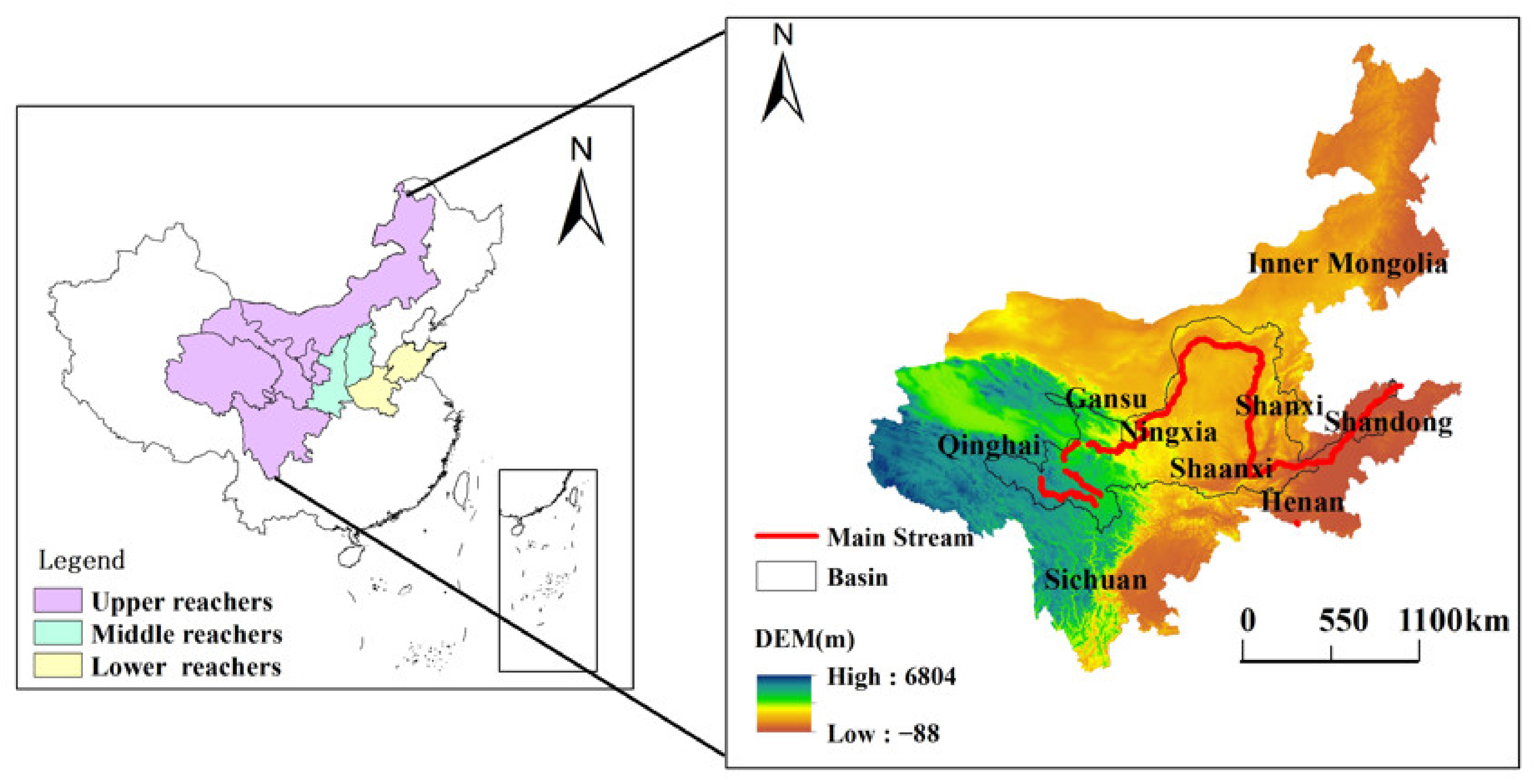


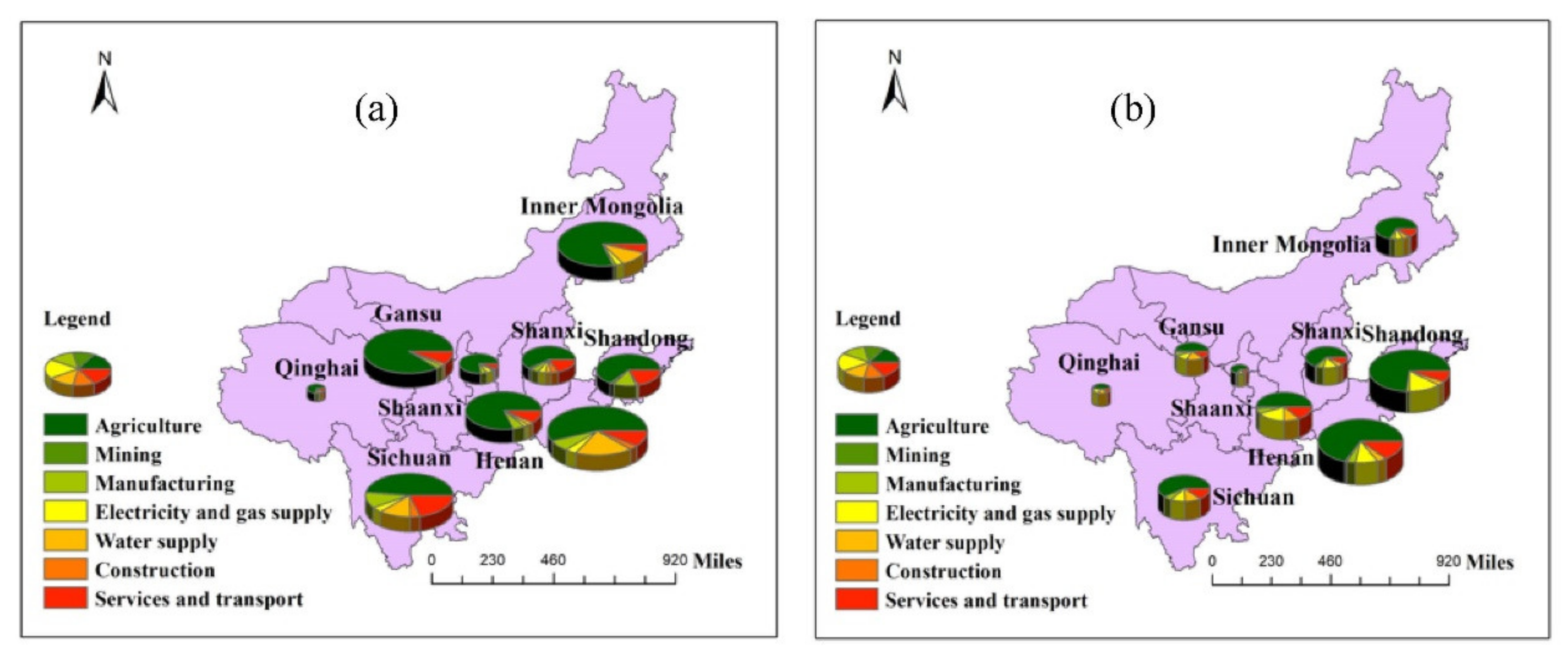
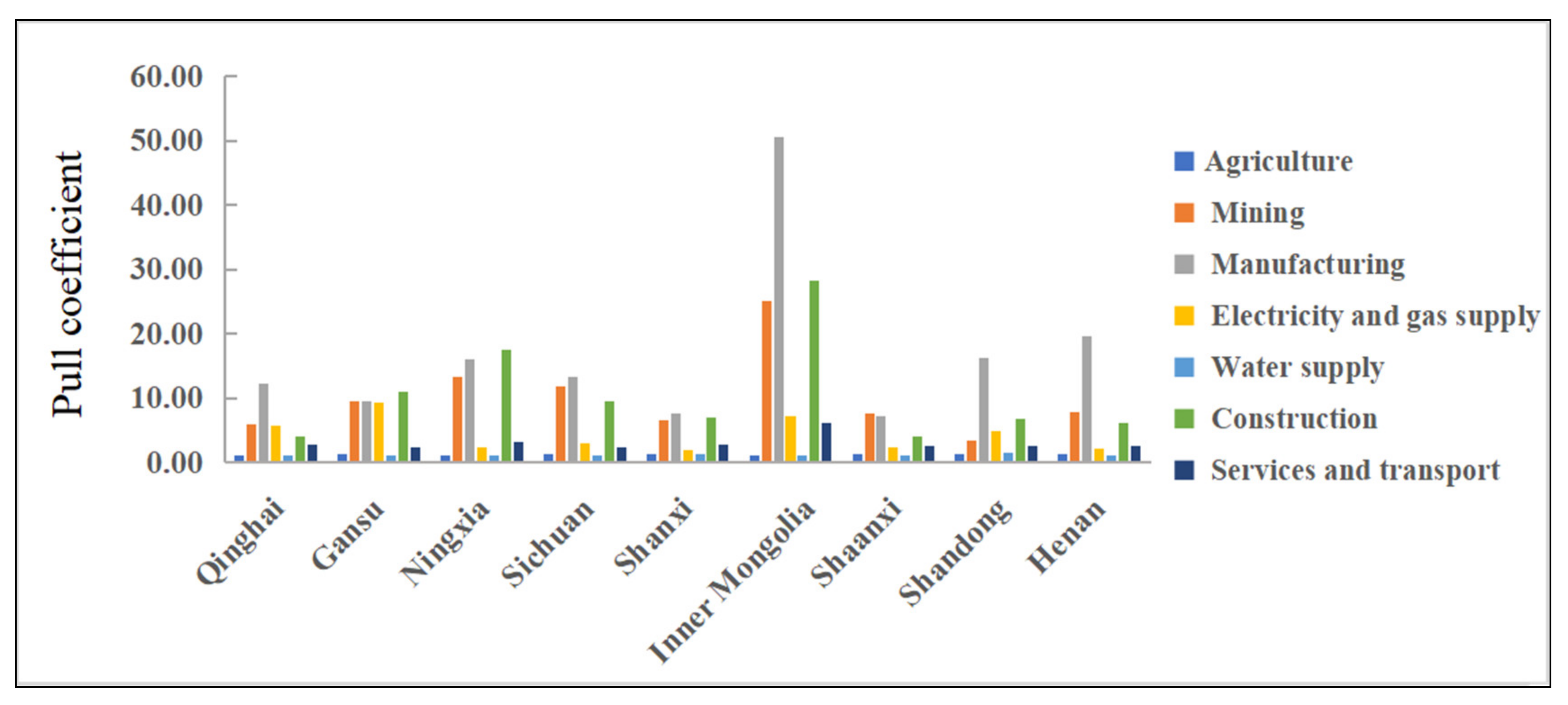

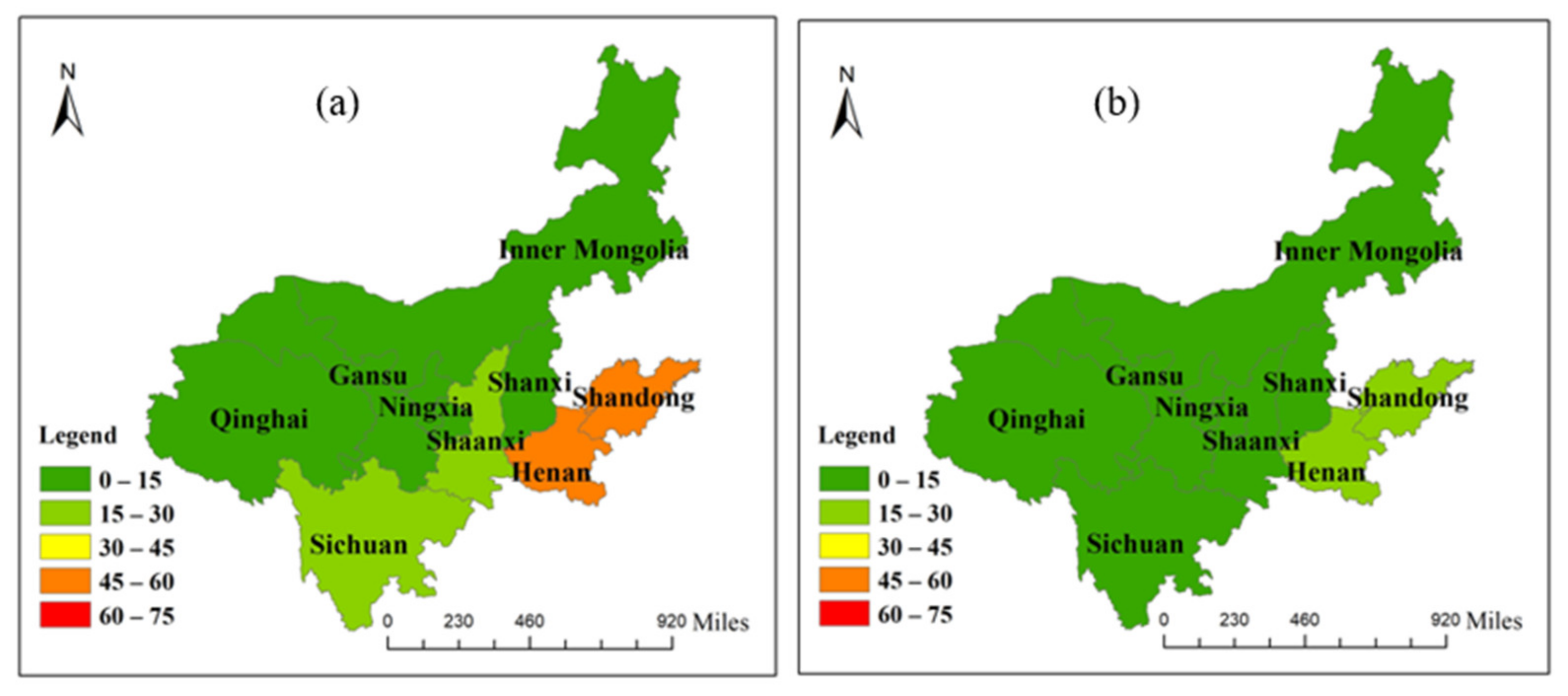
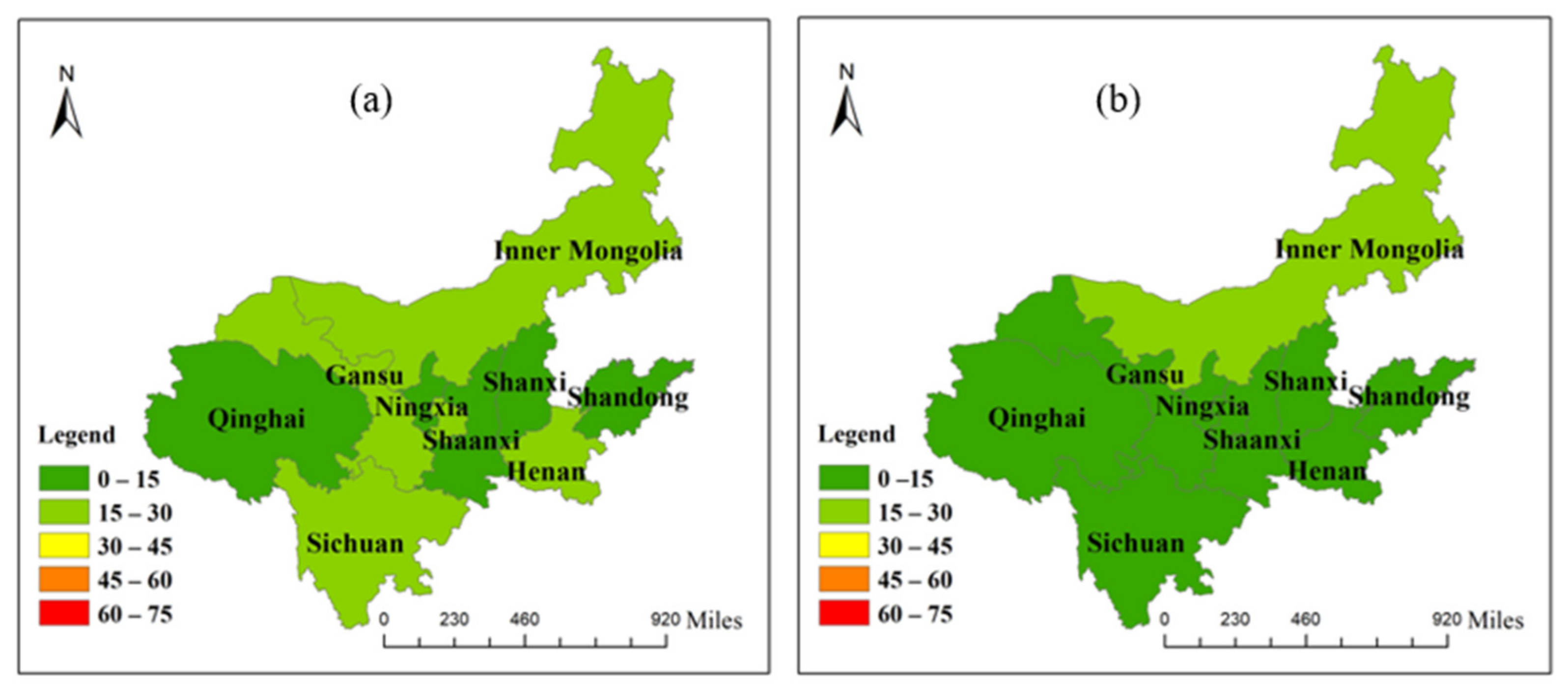
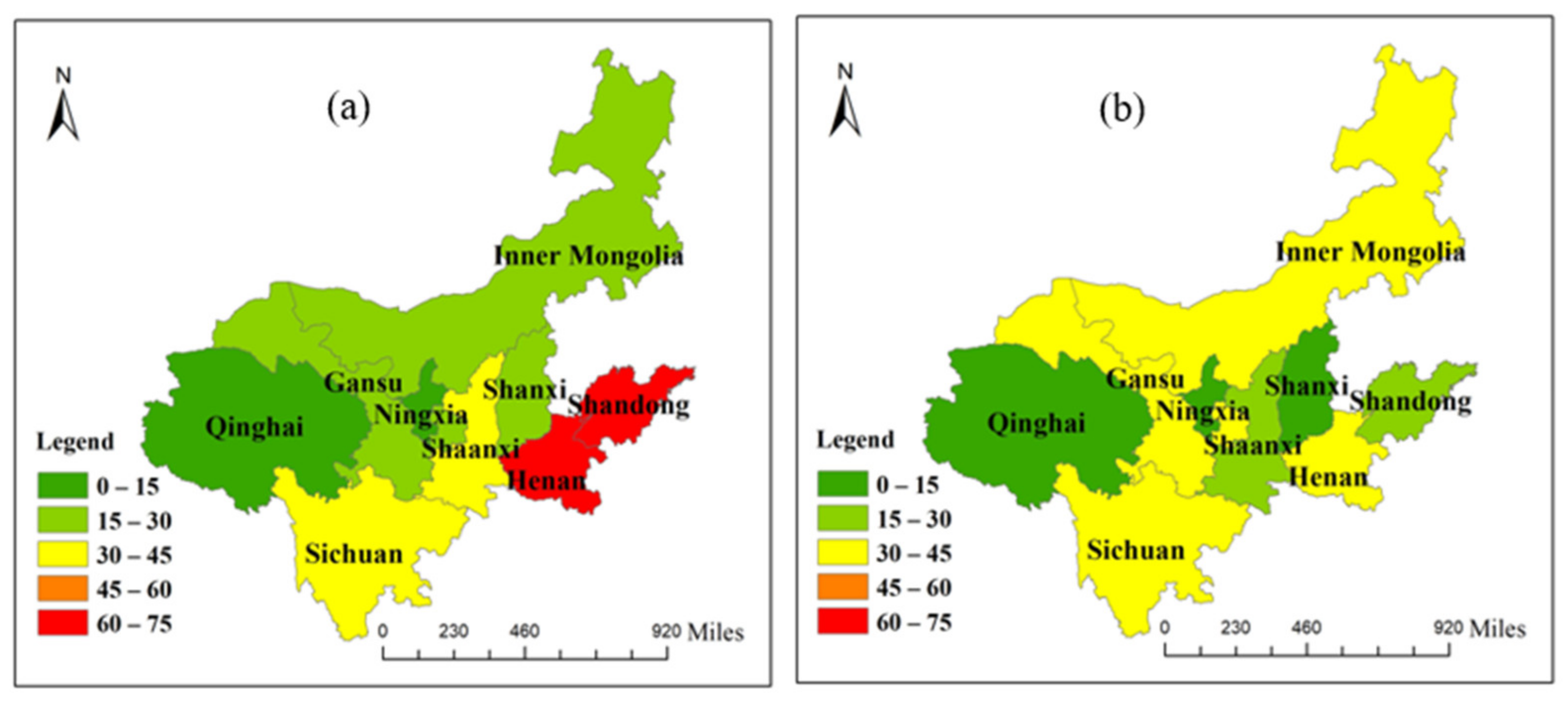
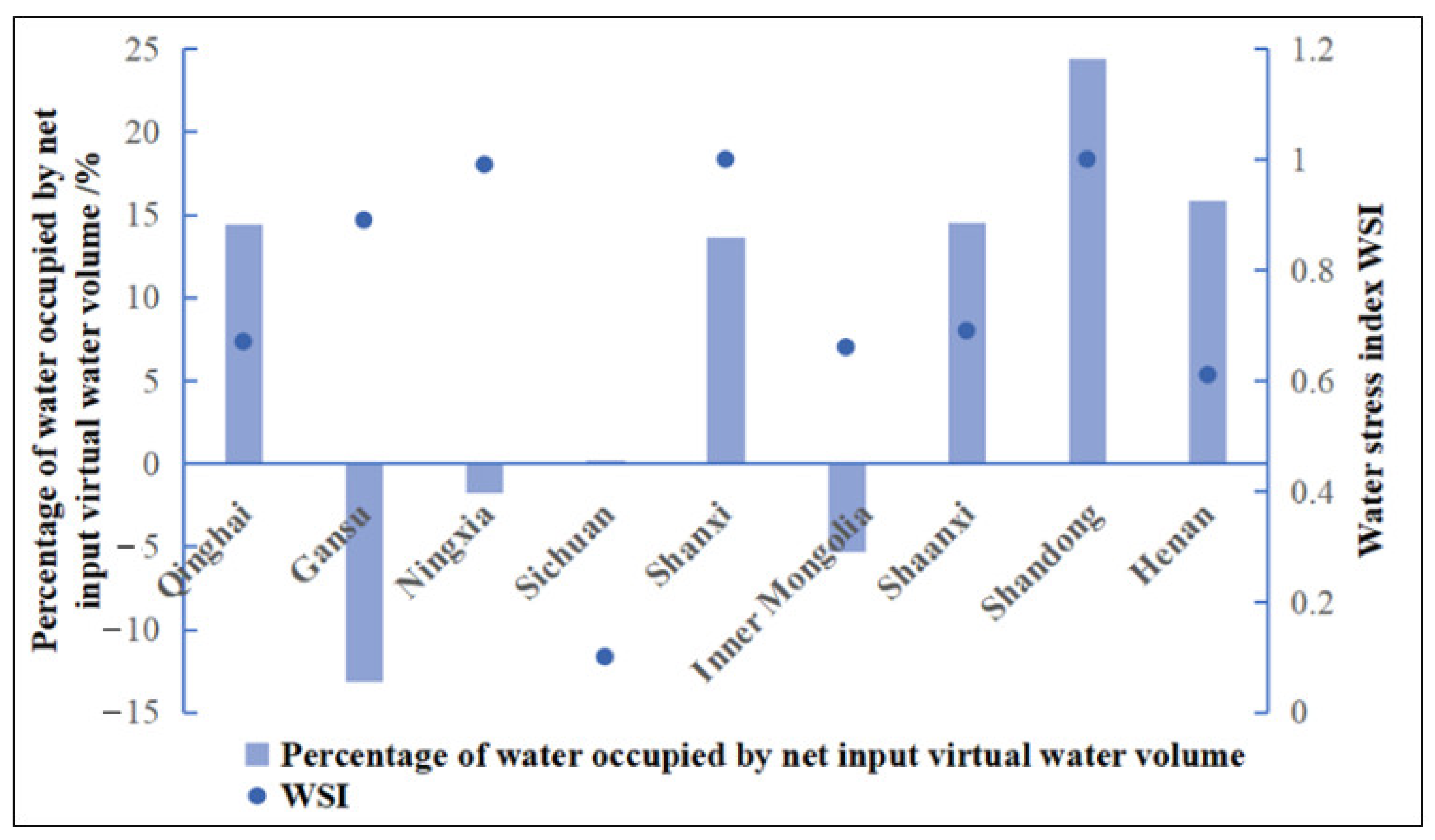
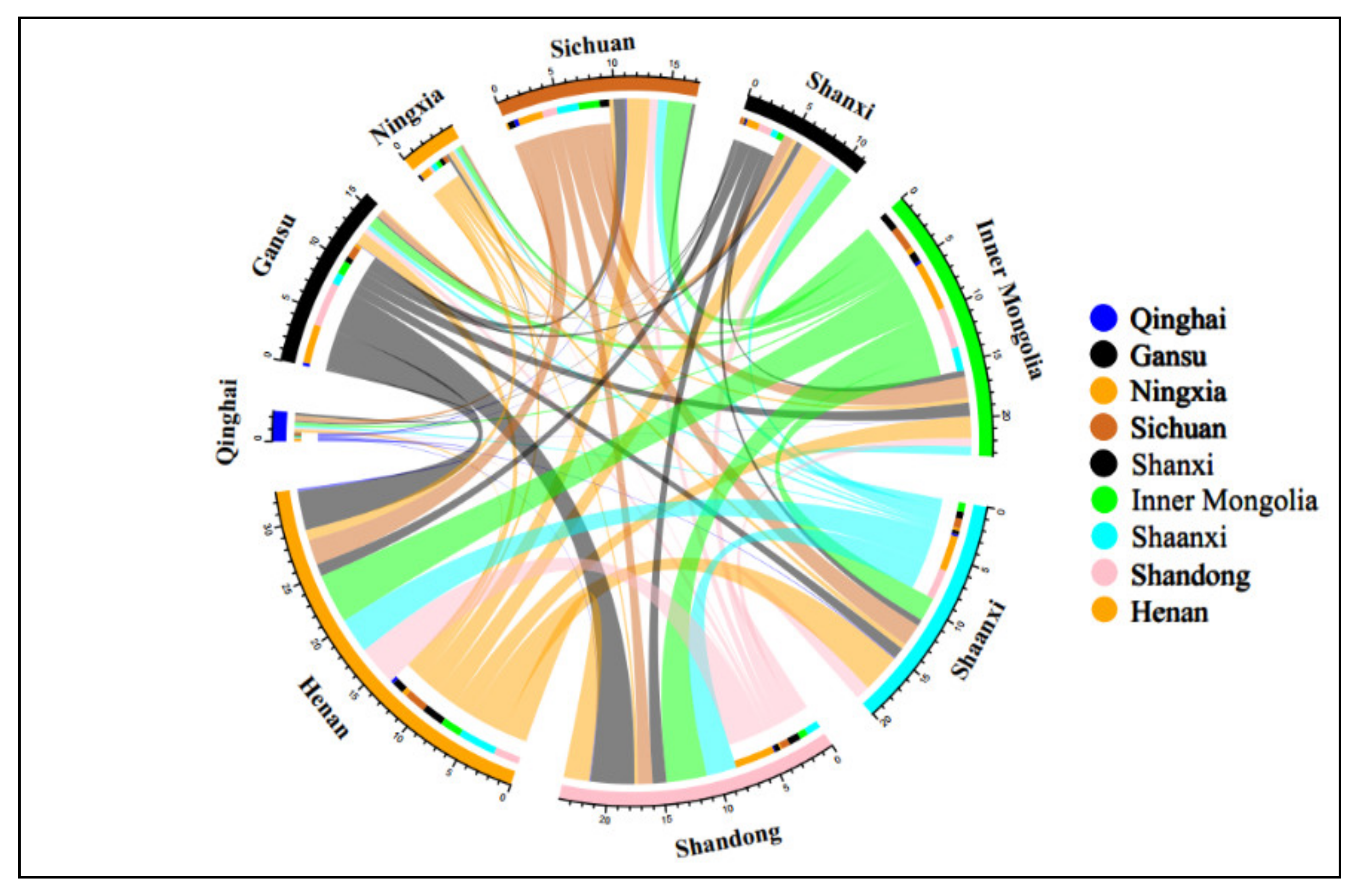
| Province (Region) | Total Water Resources/100 Million m3 | Total Water Consumption/100 Million m3 | GDP/100 Million Yuan | |
|---|---|---|---|---|
| Upper reaches | Qinghai | 919.30 | 26.20 | 2965.95 |
| Gansu | 325.90 | 110.00 | 8718.30 | |
| Ningxia | 12.60 | 69.90 | 3748.48 | |
| Sichuan | 2748.90 | 252.40 | 46,615.82 | |
| Inner Mongolia | 447.90 | 190.90 | 17,212.53 | |
| Middle reaches | Shanxi | 97.30 | 76.00 | 17,026.68 |
| Shaanxi | 495.30 | 92.60 | 25,793.17 | |
| Lower reaches | Shandong | 195.20 | 225.30 | 71,067.53 |
| Henan | 168.60 | 237.80 | 54,259.20 | |
| The Yellow River Basin | 5411.00 | 1281.10 | 247,407.66 | |
| Whole country | 29,041.00 | 6021.20 | 986,515.20 | |
| Percentage of Yellow River Basin in China | 18.63% | 21.28% | 25.08% | |
| Percentage of upper reaches in the Yellow River Basin | 82.32% | 50.69% | 32.04% | |
| Percentage of middle reaches in the Yellow River Basin | 10.95% | 13.16% | 17.31% | |
| Percentage of lower reaches in the Yellow River Basin | 6.72% | 36.15% | 50.66% | |
| Item | Intermediate Use | Final Demand | Export | Total Output | ||||||
|---|---|---|---|---|---|---|---|---|---|---|
| Qinghai | … | Henan | Other Regions | Qinghai … Henan | Other Regions | |||||
| Sector1 … Sector42 | … | Sector1 … Sector42 | Sector1 … Sector42 | |||||||
| Intermediate input | Qinghai | Sector1 | … | |||||||
| … | … | … | … | … | … | … | … | … | ||
| Sector42 | … | |||||||||
| … | … | … | … | … | … | … | … | … | … | |
| Henan | Sector1 | … | ||||||||
| … | … | … | … | … | … | … | … | … | ||
| Sector42 | … | |||||||||
| Combined 7 Sectors | Department Abbreviation |
|---|---|
| Agriculture | AG |
| Mining | MI |
| Water supply | WA |
| Electricity and gas supply | EL |
| Manufacturing | MA |
| Construction | CO |
| Services and transport | ST |
Publisher’s Note: MDPI stays neutral with regard to jurisdictional claims in published maps and institutional affiliations. |
© 2022 by the authors. Licensee MDPI, Basel, Switzerland. This article is an open access article distributed under the terms and conditions of the Creative Commons Attribution (CC BY) license (https://creativecommons.org/licenses/by/4.0/).
Share and Cite
Liu, X.; Xiong, R.; Guo, P.; Nie, L.; Shi, Q.; Li, W.; Cui, J. Virtual Water Flow Pattern in the Yellow River Basin, China: An Analysis Based on a Multiregional Input–Output Model. Int. J. Environ. Res. Public Health 2022, 19, 7345. https://doi.org/10.3390/ijerph19127345
Liu X, Xiong R, Guo P, Nie L, Shi Q, Li W, Cui J. Virtual Water Flow Pattern in the Yellow River Basin, China: An Analysis Based on a Multiregional Input–Output Model. International Journal of Environmental Research and Public Health. 2022; 19(12):7345. https://doi.org/10.3390/ijerph19127345
Chicago/Turabian StyleLiu, Xiuli, Rui Xiong, Pibin Guo, Lei Nie, Qinqin Shi, Wentao Li, and Jing Cui. 2022. "Virtual Water Flow Pattern in the Yellow River Basin, China: An Analysis Based on a Multiregional Input–Output Model" International Journal of Environmental Research and Public Health 19, no. 12: 7345. https://doi.org/10.3390/ijerph19127345
APA StyleLiu, X., Xiong, R., Guo, P., Nie, L., Shi, Q., Li, W., & Cui, J. (2022). Virtual Water Flow Pattern in the Yellow River Basin, China: An Analysis Based on a Multiregional Input–Output Model. International Journal of Environmental Research and Public Health, 19(12), 7345. https://doi.org/10.3390/ijerph19127345





